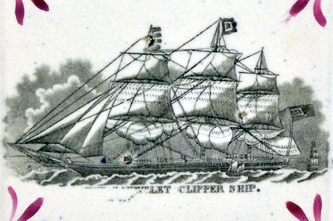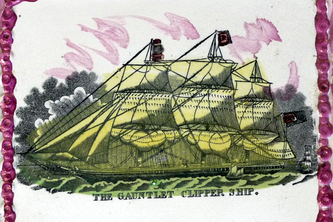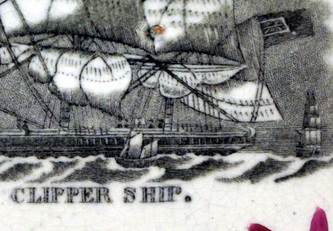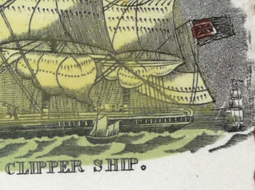|
The Gauntlet Clipper Ship in my July 27 posting, was another fly in the ointment of my attempts to attribute round-cornered plaques (see previous three blog posts). The transfer is most commonly associated with the Garrison pottery, on plaques bearing the impressed mark 'Dixon Co'. Below left is the transfer as it appears on my Garrison plaque, and on the right as it appears on the pink round-cornered plaque. There aren't any obvious flaws common to both transfers that I could find. The missing part of the title on the left plaque arose when the transfer was applied, rather than being a fault on the copper plate (I've seen Garrison plaques with the full title). Also, without having seen the right plaque, it is difficult to balance the contrast in Photoshop, and make images for fair comparison. Interestingly, just as with Bretagne, the transfer sits more obviously on the surface of the round-cornered plaque. Ian Sharp says that on these plaques, the transfer was applied over a glaze. Whereas the Garrison transfer, printed straight onto pottery, appears to have been partially absorbed by the body. Looking at the details though (compare the spacing of the lettering), I think there is little doubt that the transfers come from the same copper plate.
Another factor, I'd not previously considered, is that copper plates were sometimes re-engraved. Appendix III (Baker) states: Because copper is a relatively soft metal the transfer plates were subject to a good deal of wear and required repair. Engraved lines which had become too shallow to hold the required amount of ink were retouched and the plates themselves, which had gradually become curved due to being squeezed between the plate rollers, were flattened out. I wonder whether the diagonal hatching in the clouds to the left of the ship (on the second plaque), might be such an attempt to improve the quality of the image. According to Baker, the Garrison Pottery sold its copper transfer plates when it closed (1865). One such plate was presented to the Sunderland Museum by a member of the Ball family in 1963, engraved with the name 'Dixon, Phillips & Co'. Baker writes 'this copper plate appears to have been passed into the hands of Moore's or Scott's (possibly both) and finally to Ball Brothers'. None of that really helps with our attribution. What we can say with some certainty is that the round-cornered Gauntlet plaque post dates 1865. The first Garrison Gauntlet plaques were likely produced just after 1853 when the ship was launched.
0 Comments
Leave a Reply. |
AuthorStephen Smith lives in London, and is always happy to hear from other collectors. If you have an interesting collection of plaques, and are based in the UK, he will photograph them for you. Free advice given regarding selling and dispersal of a collection, or to those wishing to start one. Just get in touch... Archives
February 2022
AcknowledgementsThis website is indebted to collectors, dealers and enthusiasts who have shared their knowledge or photos. In particular: Ian Holmes, Stephen Duckworth, Dick Henrywood, Norman Lowe, Keith Lovell, Donald H Ryan, Harold Crowder, Jack and Joyce Cockerill, Myrna Schkolne, Elinor Penna, Ian Sharp, Shauna Gregg at the Sunderland Museum, Keith Bell, Martyn Edgell, and Liz Denton.
|



